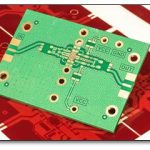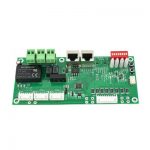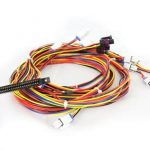Introduction to PCB Conductivity
Printed Circuit Boards (PCBs) are the backbone of modern electronics, providing a platform for interconnecting electronic components. The conductivity of the PCB plays a crucial role in determining the performance, reliability, and functionality of the electronic device. Two essential elements that contribute to PCB conductivity are vias and traces.
What are Vias?
Vias are small holes drilled through the PCB to establish electrical connections between different layers of the board. They are typically plated with a conductive material, such as copper, to ensure reliable electrical connectivity. Vias come in different types, including:
- Through-hole vias
- Blind vias
- Buried vias
- Micro vias
What are Traces?
Traces are the conductive paths that run along the surface of the PCB, connecting components and vias. They are usually made of copper and are etched onto the PCB substrate. The width, thickness, and spacing of traces determine their current-carrying capacity and impedance characteristics.
Factors Affecting PCB Conductivity
Several factors influence the conductivity of a PCB, including:
1. Material Properties
The choice of materials used in PCB Fabrication significantly impacts its conductivity. The most common materials used are:
- FR-4: A glass-reinforced epoxy laminate with good insulation properties and moderate dielectric constant.
- Polyimide: A high-performance substrate with excellent thermal stability and low dielectric constant.
- Teflon: A low-loss substrate with superior high-frequency performance and low dielectric constant.
2. Copper Thickness
The thickness of the copper layer on the PCB affects its conductivity. Thicker copper layers offer lower resistance and higher current-carrying capacity. Common copper thicknesses used in PCBs are:
| Copper Weight (oz) | Thickness (μm) |
|---|---|
| 0.5 | 17.5 |
| 1 | 35 |
| 2 | 70 |
| 3 | 105 |
3. Trace Geometry
The width, thickness, and spacing of traces on a PCB influence its conductivity. Wider traces have lower resistance and can carry more current, while narrower traces are suitable for high-density designs. The spacing between traces affects the board’s impedance and crosstalk characteristics.
4. Via Design
The design of vias, including their size, placement, and plating, affects PCB conductivity. Smaller vias offer higher density but may have higher resistance. Proper via placement is essential to minimize signal integrity issues and ensure reliable connections between layers.
Calculating PCB Conductivity
To determine the conductivity of a PCB, you need to consider the resistance of traces and vias. The resistance of a trace can be calculated using the following formula:
R = ρ × L / (W × T)
Where:
– R = Resistance (Ω)
– ρ = Resistivity of the conductor material (Ω·m)
– L = Length of the trace (m)
– W = Width of the trace (m)
– T = Thickness of the trace (m)
The resistance of a via depends on its length, diameter, and plating thickness. The following table provides typical resistance values for different Via sizes:
| Via Diameter (mm) | Plating Thickness (μm) | Resistance (mΩ) |
|---|---|---|
| 0.2 | 25 | 10-20 |
| 0.3 | 25 | 5-10 |
| 0.5 | 25 | 2-5 |
| 0.8 | 25 | 1-2 |

Optimizing PCB Conductivity
To optimize the conductivity of a PCB, consider the following best practices:
-
Choose appropriate materials based on the application requirements, such as FR-4 for general-purpose designs or Teflon for high-frequency applications.
-
Use thicker copper layers to reduce resistance and increase current-carrying capacity, especially for power delivery traces.
-
Design traces with appropriate width and spacing to minimize resistance and maintain signal integrity. Use PCB design tools to calculate the optimal trace geometry based on the required impedance and current-carrying capacity.
-
Minimize the use of vias, especially in high-speed signal paths, to reduce discontinuities and signal reflections. When necessary, use appropriate via sizes and plating thicknesses to ensure reliable connections and minimize resistance.
-
Use ground planes and power planes to provide low-impedance paths for return currents and reduce electromagnetic interference (EMI).
-
Consider using advanced PCB manufacturing techniques, such as high-density interconnect (HDI) or embedded components, to improve conductivity and reduce board size.
Frequently Asked Questions (FAQ)
1. What is the difference between a via and a trace?
A via is a small hole drilled through the PCB to establish electrical connections between different layers, while a trace is a conductive path that runs along the surface of the PCB, connecting components and vias.
2. How does copper thickness affect PCB conductivity?
Thicker copper layers offer lower resistance and higher current-carrying capacity, improving PCB conductivity. Increasing the copper thickness allows for better power delivery and signal integrity.
3. What is the most common material used for PCB fabrication?
FR-4, a glass-reinforced epoxy laminate, is the most common material used for PCB fabrication due to its good insulation properties, moderate dielectric constant, and cost-effectiveness.
4. How can I optimize trace geometry for better conductivity?
To optimize trace geometry for better conductivity, consider using wider traces for power delivery and sensitive signal paths, maintain appropriate spacing between traces to minimize crosstalk, and use PCB design tools to calculate the optimal trace geometry based on the required impedance and current-carrying capacity.
5. What are some advanced PCB manufacturing techniques that can improve conductivity?
Advanced PCB manufacturing techniques that can improve conductivity include high-density interconnect (HDI), which allows for finer trace widths and smaller vias, and embedded component technology, which integrates passive components within the PCB substrate, reducing the need for surface-mounted components and improving signal integrity.
Conclusion
Vias and traces play a crucial role in determining the conductivity of a PCB. By understanding the factors that affect PCB conductivity, such as material properties, copper thickness, trace geometry, and via design, engineers can optimize their PCB designs for better performance, reliability, and functionality. Applying best practices and leveraging advanced manufacturing techniques can further enhance PCB conductivity and meet the ever-increasing demands of modern electronic devices.






Leave a Reply